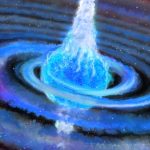Key Takeaways:
- Cosmic filaments, colossal tubes of galaxies, have been discovered to spin, challenging previous assumptions about cosmic structures.
- These filaments are hundreds of millions of light-years long, dwarfing even galaxy clusters in size.
- Researchers used data from the Sloan Digital Sky Survey to analyze over 17,000 filaments, observing the rotational movement of galaxies within them.
- The fastest recorded rotation was approximately 223,700 mph (360,000 kph), suggesting a significant rotational force at play.
- The origin of this rotation remains a mystery, with one theory proposing that gravitational forces may have induced the spin.
In a groundbreaking revelation, recent research has unveiled a cosmic phenomenon that challenges previous conceptions of celestial structures. Massive tendrils of galaxies, spanning hundreds of millions of light-years, have been discovered to possess a remarkable attribute—they spin.
Until now, it was widely believed that giant clusters of galaxies exhibited little to no rotational motion, leading many researchers to assume that cosmic scales marked the limit of spinning phenomena. However, a study led by cosmologist Noam Libeskind and his team at the Leibniz Institute for Astrophysics Potsdam in Germany has unveiled the astonishing reality: these cosmic filaments, composed of galaxies, are colossal structures surpassing even the size of galaxy clusters.
Previous scientific inquiries proposed that after the universe’s inception in the Big Bang approximately 13.8 billion years ago, a substantial portion of the gas constituting the known cosmic matter coalesced into monumental sheets. These sheets subsequently fragmented, giving rise to the filaments forming an intricate cosmic web.
Drawing on data from the Sloan Digital Sky Survey, scientists scrutinized over 17,000 of these filaments, meticulously examining the velocity at which galaxies within them moved. The astonishing revelation was that these galaxies exhibited a rotational pattern around the central axis of each filament.
The fastest recorded rotational speed observed was a staggering 223,700 mph (360,000 kph), underscoring the magnitude of the forces at play within these cosmic tendrils. It’s important to note that not every filament in the universe displays this spinning motion, but it does establish the existence of such phenomena.
The pivotal question now arises: what impels these filaments to spin? Given that the Big Bang did not confer any initial spin to the universe, the origin of this rotational motion must have emerged later in cosmic history, coinciding with the formation of these colossal structures.
One plausible explanation posits that the potent gravitational fields of these filaments induced the collapse and convergence of gas, dust, and other materials, generating shearing forces that set the rotation in motion. Nevertheless, the precise mechanisms behind this phenomenon remain uncertain, prompting further scientific inquiry.
Currently, researchers are embarking on ambitious computer simulations to gain deeper insights into how matter behaves on the grandest cosmological scales. The study’s findings, detailed in the journal


